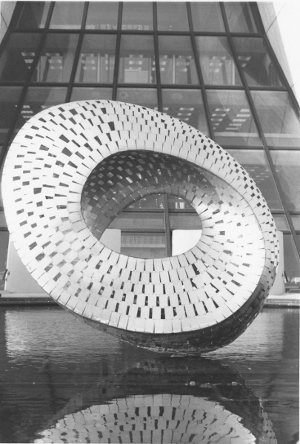By Marc Merlin

Mobius Strip, a sculpture by Robert Wilson at Fermi National Accelerator Laboratory (Marc Merlin, 1976)
It was April 17, 1969, Richard Nixon was three months into his first term as President of the United States, the homes of the inner-city were crumbling, the Vietnam War was raging and $250 million was still a whole lot of money.
$250 million was the price tag attached to the construction of what was to be the largest atom smasher in the world, a particle accelerator consisting of a ring of magnets 4 miles in circumference to be situated in a tunnel a few dozen feet beneath the surface of restored Illinois prairie west of Chicago, designed to send protons flying around in a circle at near the speed of light.
It was the job of John O. Pastore, Senator from Rhode Island and Vice Chairman of the Joint Committee on Atomic Energy, at the AEC hearing that day to find out exactly what good could be accomplished with such an expensive machine, because it would be his responsibility to “carry the ball” as a request to the Appropriations Committee, itself troubled by other pressing concerns such as “feeding the hungry and clothing the naked.” The senator, needless to say, wanted to find a practical peg upon which to hang his fiscal hat.
With mounting frustration Pastore continued his questioning that afternoon with a second witness, Robert R. Wilson, the director of the proposed facility that would one day be known as Fermilab. The Cold War being what it was and funding of competition with the Soviet Union requiring scant justification, Pastore decided to explore what he no doubt thought would be a promising new line of inquiry.
Senator Pastore: Is there anything connected in the hopes of this accelerator that in any way involves the security of the country?
Dr. Wilson: No, sir; I do not believe so.
Senator Pastore: Nothing at all?
Dr. Wilson: Nothing at all.
Robert Wilson, it turns out, was no stranger to the morally fraught intersection of military necessity and scientific progress. A Wunderkind of cyclotron physics in the 1930s, as the youngest group leader in the experimental division of the Manhattan Project, Wilson had stoked the ire of General Leslie Groves, the Army commander in charge of that effort, with his suggestion that their work on the atomic bomb might end with the defeat of Nazi Germany. That episode marked the beginning of Wilson’s life as an advocate for a public policy fully informed by knowledge of potential dangers posed by advances in science.
But Robert Wilson was also by avocation an artist and an architect and, as Senator Pastore pressed his point, Wilson made his own perspective clear.
Senator Pastore: Is there anything here that projects us in a position of being competitive with the Russians, with regard to this race?
Dr. Wilson: Only from a long-range point of view, of developing technology. Otherwise, it has to do with: Are we good painters, good sculptors, great poets? I mean all the things that we really venerate and honor in our country and are patriotic about. In that sense, this new knowledge has all to do with honor and country but it has nothing to do directly with defending our country except to help make it worth defending.
Whether or not this was the answer that Senator Pastore wanted to hear, it was apparently enough of a ball for him to carry to the Appropriations Committee to persuade them to cut Wilson a $250 million check. Operations of at the National Accelerator Laboratory began under Wilson’s direction in June 1972, on time and under budget.
I was fortunate enough to meet Robert Wilson while I was a graduate student working at Fermilab in 1976 and 1977. In a place where it was not uncommon to see a Nobel laureate or two having lunch in the cafeteria on any given afternoon, Wilson commanded a special kind of reverence. As time has passed I have come to understand better and better why.
Marc Merlin is a full-time science advocate and Director of the Atlanta Science Tavern. He writes occasionally about film, politics and, yes, science on his blog, Thoughts Arise.
